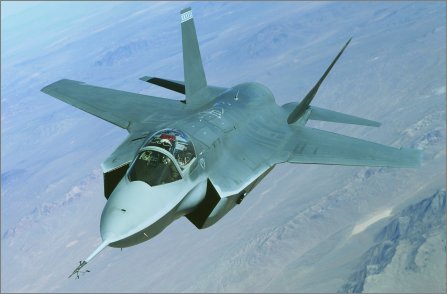More platforms identified for F-22A, F-35 technologies
Infrared-based sensors now in Lockheed Martin’s laboratory could have broader applications than originally thought, according to business development staff now unveiling alternatives to previously single-mission or single-platform sensors. A missile launch detector (MLD) developed for the US Air Force’s Lockheed F-22A Raptor could also serve as a powerful situational awareness tool, while the F-35 Joint Strike Fighter’s (JSF) electro-optical targeting system (EOTS) could be of use for stealth bombers and unmanned strike aircraft.

Programme officials are seeking to approach the US military and domestic and international aircraft manufacturers about potential new applications for Lockheed’s EOTS and MLD systems, both of which are starting to emerge in usable form. The first developmental EOTS for the F-35’s system development and demonstration programme will be installed in June on Northrop Grumman’s BAE One-Eleven avionics testbed and is scheduled to fly aboard the JSF for the first time in August 2008. The system will allow an F-35 pilot to passively search for targets in both air-to-air and air-to-ground modes, preserving the platform’s low-observable characteristics while locking on to a target.
In Lockheed’s view, that capability would also be of great utility to other stealthy platforms, such as the USAF’s Northrop B-2 bomber, and for US and international unmanned air vehicle programmes, says Don Bolling, business development manager for JSF EOTS. The B-2 is being upgraded with a Ku-band active electronically scanned array radar, but its emissions will be a source of concern for maintaining the bomber’s stealthy profile. Lockheed plans to brief the concept to USAF officials soon, but has not yet assessed the feasibility of using the B-2’s existing wiring and processors to incorporate the EOTS.
Another technical application with promise concerns infrared (IR) missile detection systems, such as the F-22A’s MLD. Lockheed has relied exclusively on IR-based technology for missile warners, including in its proposal for the USAF’s planned next-generation missile warning system.
The F-22A’s MLD includes six IR cameras positioned around the aircraft to provide full-circle coverage, with the company likening this technology to the F-35’s distributed aperture system. Each camera creates a video image of the surrounding environment, but this is not currently viewable by the Raptor’s pilot. The air force could integrate a new processor to transmit these images to a cockpit or helmet-mounted display, providing the pilot with a 360˚ view of the surrounding environment, says Lockheed.
The US Navy has already stepped forward as a potential early customer, it says, with the service having a requirement to equip its fighters with a directional infrared countermeasures suite that will also provide greater situational awareness. The company also views the US Army’s attack and utility helicopters as potential candidate platforms.
STEPHEN TRIMBLE / ORLANDO
Source: Flight International























